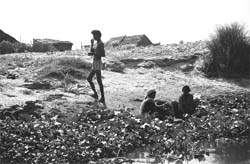Revive the Yamuna
 with the Yamuna dead, Delhi's aquifers almost empty and the watertable having fallen more than 7.5 metres in less than 20 years, the state government is considering three proposals for water harvesting in the capital. All of them deal with traditional water harvesting methods, reviving the Yamuna and its ancient channels, and percolation of monsoon waters to the underground aquifers.
with the Yamuna dead, Delhi's aquifers almost empty and the watertable having fallen more than 7.5 metres in less than 20 years, the state government is considering three proposals for water harvesting in the capital. All of them deal with traditional water harvesting methods, reviving the Yamuna and its ancient channels, and percolation of monsoon waters to the underground aquifers.
The first proposal by the Pani Morcha, a non-governmental organisation of the capital's water conscious citizens, was submitted to chief minister Shiela Dikshit and revolves around the revival of the Yamuna. It proposes to treat the sewage being pumped into the Yamuna and use it for recharging the groundwater. According to the secretary of Pani Morcha, Commander Sureshwar Sinha, the Yamuna is undergoing a reverse flow, meaning the river is drawing water from the aquifers instead of recharging the groundwater.This is happening because there is virtually no flow of water in the river.
Another suggestion made by the Morcha is a biological cleaning of the Yamuna's sewage. Duckweed and common fish could be used to clean up the toxic water. "It's cheap and effective, unlike the Ganga Action Plan," he says.
The Central Ground Water Board's ( cgwb ) plan involves extraction and replenishment of groundwater to augment the city's water supply. This would be done in the flood plains of the Yamuna in five zones of the National Capital Region ( ncr ) of Delhi during the April-May-June period. The idea being to pump out the groundwater of these five zones through the construction of tube-wells. cgwb claims that the scheme would supply Delhi with an additional 909 million litres of water per day. The first phase, which has already been put into action, will cost Rs 25 crore. The monsoons are expected to recharge the aquifers.
Lastly an Indian National Trust for Art and Cultural Heritage ( intach ) study found that Delhi has several old water channels and roof-top water harvesting systems which can recharge the groundwater. The intach proposal to use drain No 6 (the old Yamuna river bed), the Najafgarh drain and other drains as reservoirs for excess monsoon water has been approved by the government. Besides there is a suggestion to divert water from the Western Yamuna canal to the Budhi nala.
But by simply trapping rainwater on roof-tops could provide around 300 litres per minute as it rains well in Delhi. The city's master-plan projects a per capita need of 400 litres per day. Thus, Delhi would have a surplus stock of water from roofs itself.
A cgwb estimate puts the cost of a roof-top harvesting system for an average size house at Rs 1.5 lakh and a cgwb study shows that the cost of bringing a gallon of water from the Tehri dam to Delhi can be 10 to 20 times costlier than the cost of recharging the groundwater within the city.
Related Content
- Report on encroachment of Yamuna flood plains, Mathura, Uttar Pradesh, 01/09/2020
- Order of the National Green Tribunal regarding water management in Delhi, 03/02/2020
- Nine projects flagged off to clean Yamuna
- Hardlook: A look at troubled waters of Yamuna floodplains one year after World Culture Festival
- Environmentalist seeks human status for Godavari
- Here's a Rs 6,000-crore plan to give Yamuna back to city
